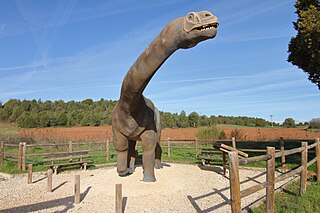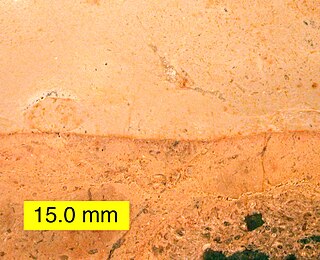| Tecocoyunca Group | |
|---|---|
| Stratigraphic range: Mesozoic | |
| Type | Geological formation |
The Tecocoyunca Group is a Mesozoic geologic formation in Mexico. Fossil sauropod tracks have been reported from the formation. [1]

Neosodon was a genus of sauropod dinosaur from the Late Tithonian-age Upper Jurassic Sables et Gres a Trigonia gibbosa of Pas-de-Calais department, France. It has never been formally given a species name, but is often seen as N. praecursor, which actually comes from a different animal. Often in the past, it had been assigned to the wastebasket taxon Pelorosaurus, but restudy has suggested that it could be related to Turiasaurus, a roughly contemporaneous giant Spanish sauropod. It is only known from six teeth.
Clasmodosaurus is a genus of titanosaurian sauropod dinosaur from the Bajo Barreal Formation. It lived during the Late Cretaceous in what is now Argentina. It is known only from three fossilized teeth, and is therefore a tooth taxon. It is a nomen dubium.
The Chuanjie Formation, is a geological formation in Yunnan, China. It dates back to the Middle Jurassic. It was formerly referred to as being the lower member of the "Upper Lufeng" as opposed to the underlying "Lower Lufeng" now referred to as the Lufeng Formation. Tracks of theropods and sauropods, as well as thyreophorans are known from the formation.
The Grès supérieurs Formation is a geological formation in Laos whose strata date back to the Aptian to Albian stages of the Early Cretaceous. Dinosaur remains are among the fossils that have been recovered from the formation. It is equivalent to the Khok Kruat Formation of Thailand.
The Arén Formation or Arén Sandstone is a geological formation in the Tremp-Graus Basin around Arén, Catalonia, Spain whose strata date back to the Late Cretaceous. Dinosaur remains are among the fossils that have been recovered from the formation. The formation dates to the Campanian to Maastrichtian and underlies the Tremp Group.
The Lomas Coloradas Formation is a Mesozoic geologic formation in Mexico. Dinosaur remains are among the fossils that have been recovered from the formation, although only a few have yet been referred to a specific genus. Indetermiate hadrosaur remains and indeterminate sauropod remains, most likely belonging to Alamosaurus, have been unearthed here.

The Saltwick Formation is a Middle Jurassic geologic formation in Yorkshire and the western North Sea. It is primarily Aalenian in age. Fossil footprints, assigned to the tetrapod ichnogenus Characichnos, as well as stegosaur tracks have been reported from the formation. An indeterminate sauropod, nicknamed Alan, has also been reported from the formation.
The Zorillo Formation is a Mesozoic geologic formation in Mexico. Fossil sauropod tracks have been reported from the formation.
The Wagad Formation is a Mesozoic Late Jurassic geologic formation in India. Fossil sauropod tracks have been reported from the formation.

The White Limestone Formation is a Bathonian geologic formation in the United Kingdom, dating to the Middle Jurassic, 168.3 to 166.1 million years ago. Fossil sauropod tracks have been reported from the formation. It is the lateral equivalent of the Blisworth Limestone. It predominantly consists of grey-yellow limestone, typically wackestone and packstone with subordinate ooidal grainstone. The Woodeaton Quarry locality has yielded microvertebrates.

The Rupelo Formation is an Early Cretaceous (Berriasian) geologic formation in the Burgos Province of Castile and León in northern Spain. The formation crops out near the municipality Mambrillas de Lara in the northwesternmost part of the Cameros Basin in the Sierra de la Demanda.
The Higueruelas (Spanish) or Higuerueles Formation (Catalan) is a Tithonian geologic formation in the Teruel and Valencia provinces of Spain. Fossil sauropod tracks have been reported from the formation.

The Edwards Formation is a Mesozoic geologic formation in the United States. Fossil sauropod tracks have been reported from the formation.
The Calcários Micríticos da Serra de Aire is a Bathonian geologic formation in Portugal. Fossil sauropod tracks have been reported from the formation.
The Bhuj Formation is a Mesozoic geologic formation in India. Fossil sauropod tracks and tracks from the ichnogenera Skolithos, Diplocraterion, Pholeus and Planolites have been reported from the formation.
The Mexcala Formation is a Late Cretaceous geologic formation in Guerrero state, southern Mexico.
The Irhazer Shale or Irhazer II Formation is a Middle Jurassic geologic formation of the Irhazer Group in the Agadez Region of Niger. Fossil ornithopod tracks have been reported from the formation. The dinosaur Spinophorosaurus is known from the formation.
The Zhenzhuchong Formation is an Early Jurassic geologic formation in China. Plesiosaur remains are among the fossils that have been recovered from its strata. Remains of the prosauropod Lufengosaurus huenei have been recovered from this formation As well as dinosaur footprints.
The De Queen Formation, formerly known as the DeQueen Limestone Member is a Mesozoic geological formation located in southwestern Arkansas and southeastern Oklahoma in the United States. Fossil sauropod and theropod tracks have been reported from the formation. It preserves fossils dating back to the Cretaceous period, particularly the Albian age.